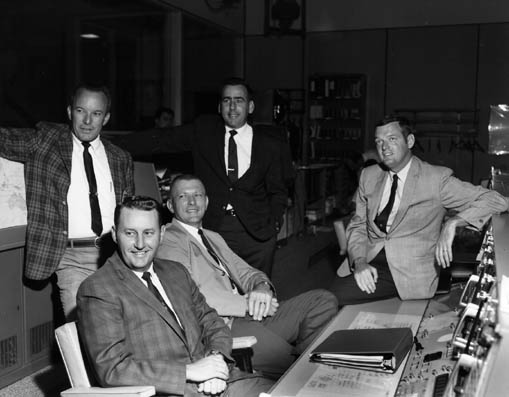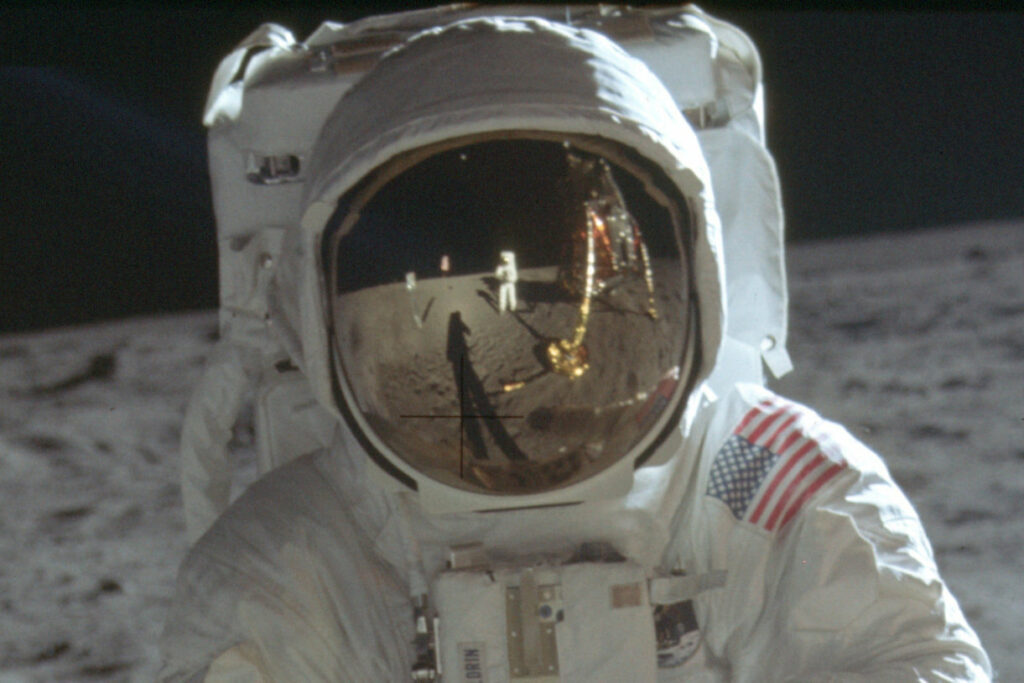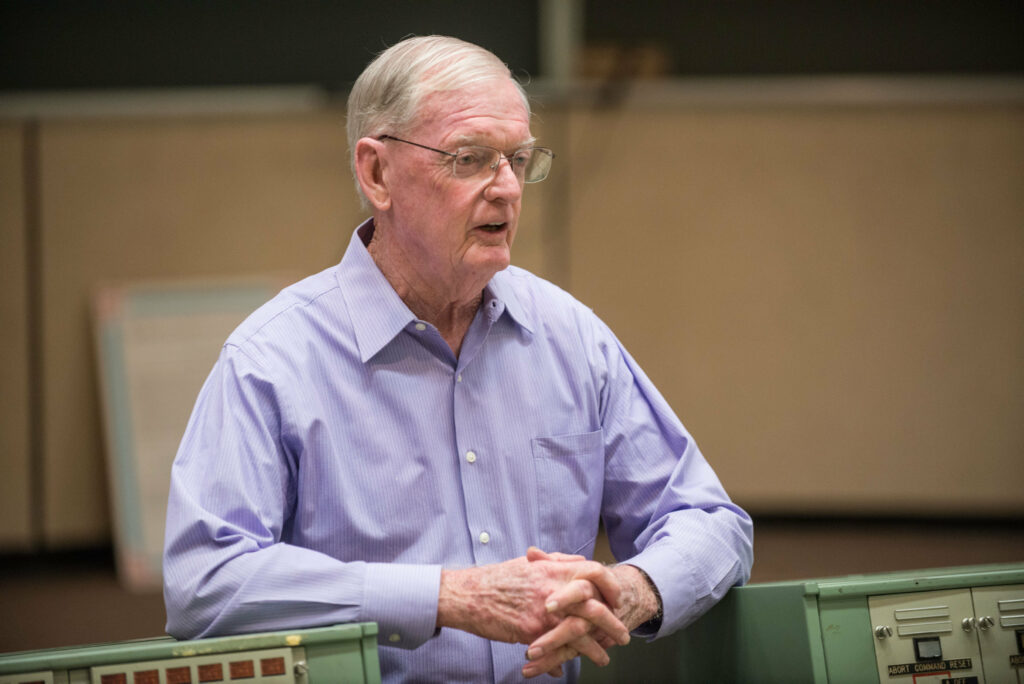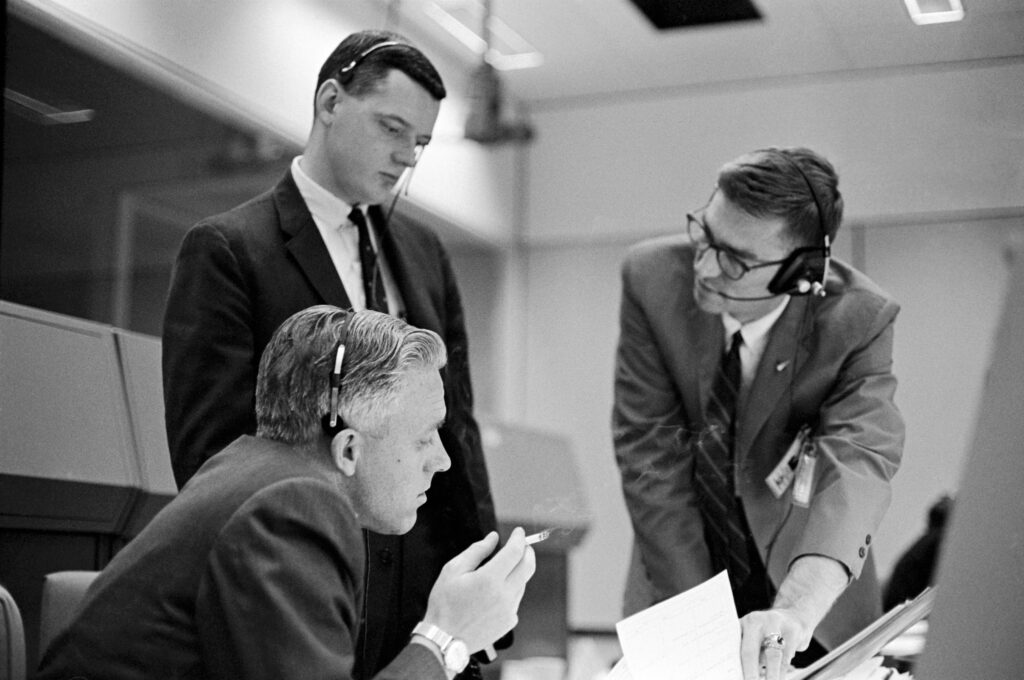Fifty years ago this week, Apollo 11 launched from Florida, broke free of Earth’s gravity, landed on the moon and delivered its three astronauts safely back home in a history-making mission.
Roughly 240,000 miles away in the comfort of Houston, Texas, the son of a coal miner stood with his eyes on the sky.
Glynn Lunney grew up in Old Forge, but by that July 1969 mission, his career had taken him to NASA’s mission control. The Scranton Preparatory School alumnus had already lived for years in Houston, from which NASA directed its spaceflights, and held key roles during the Mercury, Gemini and Apollo missions and beyond.
It’s a career that also includes numerous honors — including the Presidential Medal of Freedom as part of the Apollo 13 Mission Operations Team — but as Lunney looked back this month, much of his conversation focused on his peers rather than himself.
“It was a grand old time,” Lunney, 82, recalled. “We really enjoyed it, and I have always relished the time. And I have always been very, very proud of the young men who came, and they all did a smacked-up job.”

NASA
Apollo 11 flight directors pose for a group photo in the Mission Control Center. Pictured left to right, and the shifts that they served during the mission, are (in front and sitting) Clifford E. Charlesworth (Shift 1), Gerald D. Griffin (Shift 1), Eugene F. Kranz (Shift 2), Milton L. Windler (Shift 4), and Glynn S. Lunney (Shift 3).
From air to space
Aeronautics had long appealed to Lunney, but when it came to choosing his career, he almost ended up in a much different field.
“I got advice from one of the few people that I knew that went to college,” Lunney recalled. “Dr. (Theodore) Marmo was our family doctor and doctor for a lot of people in Old Forge. So I’d talk with him, and I told him I was interested in two things. One was I was really pretty good at numbers, so accounting came to mind first, then airplane engineer. He said, ‘Take the latter.’”
After a stint at University of Scranton, Lunney moved to University of Detroit to study aeronautical engineering, which included a cooperative training program with a research center in Cleveland. He finished school just as the United States sought to respond to Russia’s Sputnik satellite launch, and a man Lunney worked for in Cleveland, George Low, already was “active in terms of trying to chart the path for NASA and space flight at the time,” Lunney said.
“Out of a 2,000-person center there in Cleveland, I ran into the guy who was working on, ‘What is the manned space program going to look like?’” Lunney said. “He asked me if I wanted to join that, and I of course said yes.”
Missions begin
Project Mercury kicked off the United States’ manned space program in 1958, and Lunney worked as a flight dynamics officer on the project under legendary NASA flight director Chris Kraft.
“I’m really proud … when I look back and think about how well that group of young men performed,” Lunney said. “And they just were given the example by guys like Kraft and others, and I was part of the example class, although I was really pretty young. … The group of people that surrounded Chris (Kraft), I kind of had to do a lot of maturing pretty fast to catch up with that.”
As the space program advanced, Lunney helped prepare the young NASA workforce — he puts the average age in the control center during the first moon landing at 26 — to handle such duties as monitoring mission trajectories and guidance systems. They had no pattern them to follow, he noted; rather, they “invented the process of spaceflight.”
“It’s always their favorite time, looking back on their careers,” Lunney said. “Because now they’re all close to 80, and some of them are gone, and others are still around. And they stepped up to what had to be done and invented the processes that we were going to use in the control center. They just made them up and tested them 100 ways.”
Lunney served as a flight director on seven Apollo missions, a job he described as the “leader of all that went on in mission control, and all of the stuff that went up to the flight crews by way of recommendations and decisions.” He oversaw the third shift of Apollo 11.
“My shift had to do with getting them into orbit around the moon and getting them back up off the moon and doing the rendezvous with the mothership and getting them back,” Lunney explained. “And we each ran shifts that were kind of boring on the way out and back. … It was sort of a quiet time going out, because everybody was in thought about what was going to be facing them when they got there, including us in the control center. Most of the time, the trip out is fairly benign, and the activity kind of follows that.
“On the way coming back home, everybody is thinking about, well, how well did it go? Did it do something we could improve on? The wait — the sense of waiting — is gone away. We’ve been there. We did what we wanted to do.”

NEIL ARMSTRONG / NASA VIA ASSOCIATED PRESS
This detail of a July 20, 1969, photo shows astronaut Neil Armstrong reflected in the helmet visor of Buzz Aldrin on the surface of the moon.
The Eagle lands
With astronauts Neil Armstrong, Michael Collins and Edwin “Buzz” Aldrin aboard, Apollo 11 launched from Cape Kennedy, Florida, on July 16, 1969, and landed on the moon July 20.
“We were comfortable that (landing) was doable, and we could expect that we might have some problems,” Lunney recalled. “We might even have to abort it, but we (thought) we had a pretty good shot at getting the landing done perfectly well.”
Lunney called Armstrong “a terrific pilot,” but he also praised one of his control room peers, 26-year-old guidance officer Steve Bales, who monitored program alarms that began to “cluster up” as the landing approached.
“For the last minute or two, the program alarms were giving us concern because they were a concern that the computer was getting overloaded, and then it would hiccup a little bit and then they would return,” Lunney said, noting that Bales ultimately issued a “go” call to let the landing continue.
In the end, the Eagle, the lunar module, landed, and Armstrong took the first step on the surface.
“It really was an exciting time,” Lunney said. “It was a great team effort all the time. … Looking back, the reaction is one of (how) we were really in awe of how much we were allowed to do. We made all the decisions that had to be made on the flights. And that was probably best manifested in Apollo 13.”
Lunney was one of four flight directors on Apollo 13, which launched in April 1970 but never landed on the moon after an explosion damaged the spacecraft. After several harrowing days in space, the astronauts returned safely to Earth.
“We worked so well because Chris (Kraft) had trained us early on,” Lunney said. “We got to think alike.”
While Lunney does not speak well of how he was portrayed in the 1995 film “Apollo 13” (“They didn’t give me credit for any of the work that I did,” he said. “As a matter of fact, if you watch the movie, you’ll see I’m sort of portrayed as a flunky.”), he has enjoyed speaking about his experience for various television programs through the years. And the public likely will see more of him in the coming days.
“We’ve had people coming and going at the house for the last two months,” Lunney said. “A lot of the media people are storing up their movies for the (anniversary).”

ROBERT MARKOWITZ / CONTRIBUTING PHOTOGRAPHER Former NASA Flight Director Glynn Lunney meets with a group of high school aerospace scholars in what was the Apollo Mission Control room in Houston, Texas, in June 2014.
Celebrations abound
While a leukemia diagnosis has kept him from traveling much lately, Lunney did attend a ribbon-cutting ceremony for the former control room at Johnson Space Center, Houston, which was renovated to look as it did during the early space missions.
Lunney said they have enjoyed all the activity happening at the space center as the anniversary draws near.
“We’re having a number of things going on down here at the space center,” he said. “They’re all positive. They all remind us of what we did when we were young kids. It’s a wonderful time for us. ”
NASA and other groups will offer numerous activities this week, including the Apollo A-Maze-Ment, an Apollo-themed corn maze open from Thursday, July 18, to Saturday, July 20, at Cherry Crest Adventure Farm in Lancaster. And on Friday, July 19, from 1 to 3 p.m., the public can tune in to NASA TV, nasa.gov and the Discovery Science Channel to watch “NASA’s Giant Leaps: Past and Future.” Co-hosted by NASA public affairs officer Marie Lewis — an Endicott, New York, native whose father, Brian Luby, has Scranton ties — the program will visit space-related sites across the country, including Armstrong’s hometown, Wapakoneta, Ohio; the Apollo 11 command module display in Seattle and Johnson Space Center.
“We’ll use that time to tell the story of how we got to the moon,” Lewis said.
Lunar legacy
Based at Kennedy Space Center in Florida, Lewis works for NASA’s commercial crew program, which represents the next generation of spaceflight through partnerships with Boeing and SpaceX to launch American astronauts from America soil, something that last happened in 2011. Going forward, Lewis said, “NASA will be basically a paying customer” to put its astronauts into space, but that will allow it “to focus more of our resources on developing the world’s most powerful rocket to get us to the moon.”
The recently announced Artemis program — named after the twin sister of Apollo in Greek mythology — looks to return astronauts to the moon, including landing the first woman there by 2024.
“My dad was a teenager when we landed on the moon. … My generation, we’re the generation (that is) going to put the first woman on the moon,” Lewis said.
Today, Lunney sees potential in NASA’s plans. He stayed with NASA after the Apollo missions ended in December 1972, serving as U.S. technical director for the joint Apollo-Soyuz mission in 1975 and working on the Space Shuttle Program. He eventually moved to the private sector as his son, Bryan Lunney, became a flight director at NASA, working with several space shuttle flights.
Today, NASA seems like it’s on a better course to accomplish a mission to Mars than it was years ago, the elder Lunney noted.
“No matter what they say … about going back and using the moon as a place to train, they would have done that anyway,” Lunney said. “Reality would have moved that to the point where they would have done that anyway. It will all go the right way (today) because there’s a lot of people who know what the right path is, and they will gradually put it in play and learn from it.”
That’s not to say a Mars mission will be easy — or short, he pointed out. In emergencies, astronauts could return to Earth within a few hours from its orbit and in a few days from the moon, Lunney said.
“Going to Mars is a continuous process for several years to get there and to be there a while,” he said. “It’s going to take probably two years to do. … It’s a very, very long exposure to a lot of things that are difficult to defend against. … All that is in front of us, and it’s going to be a lot more serious than people think.”
For Lewis, the possibilities make it “a really exciting time to work at NASA.”
“The Apollo program was such a stunning demonstration of our country’s strength of will and our economical, technological power. … We really feel like we’re in a position to kind of reignite that excitement in the country and around the space program,” she said. “And I think we’re going to be able to inspire more young people into STEM careers and tomorrow’s workforce.”
No matter who ends up on the moon or travels to the Red Planet, they will have Lunney and thousands of other dedicated NASA workers to thank for charting the way there five decades ago.
“Looking back on it,” Lunney said, “it was a marvelous time.”

NASA / The official portrait of Dr. Glynn S. Lunney, U.S. Technical Director, Apollo-Soyuz Test Project, Johnson Space Center. The photo was taken in January 1974.
Meet Glynn Lunney
- Age: 82
- Residence: Formerly of Old Forge, he lives in Houston, Texas.
- Family: Wife, Marilyn, and four children
- Educational background: A 1953 graduate of Scranton Preparatory School, he attended University of Scranton and graduated from University of Detroit with a bachelor’s degree in aerospace engineering. He has an honorary doctorate from U of S.
- Claim to fame: He was a longtime flight director for NASA, including for Apollo 11, and also held numerous leadership positions up into the space shuttle program.He received the Presidential Medal of Freedom as part of the Apollo 13 Mission Operations Team.
New podcast
Listen to our new podcast, Historically Hip, which this week takes you back to July 1969 and the stories behind the Apollo 11 moon landing. Check it out on iTunes, Google Play and Spotify.
If you watch
- What: “NASA’s Giant Leaps: Past and Future” — Marie Lewis co-hosts a special program looking at NASA’s past and future from NASA’s Kennedy Space Center that will take viewers to special sites and programs across the country, including: the National Mall, Washington, D.C.; Johnson Space Center, Houston; the U.S. Space & Rocket Center near NASA’s Marshall Space Flight Center, Huntsville, Alabama; Neil Armstrong’s hometown, Wapakoneta, Ohio; the Apollo 11 command module display, the Museum of Flight, Seattle; and celebrations across America.
- When: July 19, 1 to 3 p.m.
- Where: Airs on NASA TV, nasa.gov and the Discovery Science Channel
- What: “STEM Forward to the Moon” — This special program special program focuses on kids participating in moon-landing simulations at Cosmosphere, Hutchinson, Kansas; St. Louis Science Center; Columbia Memorial Space Center, Downey, California; and Arizona Science Center, Phoenix. A virtual engineering design challenge also will take place on social media.
- When: Friday, July 19, 3 p.m.
- Where: Airs on NASA TV
- Details: spacestem.nasa.gov

NASA celebrations
NASA will mark the 50th anniversary of the Apollo 11 moon landing with numerous events across the country. For more information, visit nasa.gov/specials/apollo50th.
Restored Apollo Mission Control Center
NASA recently reopened to the public mission control center to look as it did during the Apollo era.
- When: Ongoing
- Where: Apollo Mission Control Center at Johnson Space Center, Houston
- Visit: nasa.gov/centers/johnson/home/index.html
Apollo 11 Launch Reflection at Pad 39A
Day includes a question-and-answer session with Apollo 11 astronauts Buzz Aldrin and Michael Collins at the historic launch pad with Kennedy Center Director Bob Cabana, plus a visit to the Launch Control Center and Firing Room 1 to visit with Apollo-era launch controllers and those involved with the present-day Artemis missions.
- When: Tuesday, July 16, 9:15 a.m. EDT
- Details: Watch live on NASA Television and NASA’s website.
World Record Model Rocket Launch Attempt
The center hosts a Guinness Book of World Records attempt for the most model rockets launching simultaneously from a single location.
- When: Tuesday, July 16, 8:32 a.m. CDT
- Where: U.S. Space & Rocket Center, Huntsville, Alabama
- Details: A 24-hour challenge, the Apollo 50th Global Rocket Launch, will occur in conjunction with partners around the world. To register, visit rocketcenter.com/ apollo50/GlobalLaunch.
Apollo 50 on the National Mall
This free event will include exhibits, speakers, demonstrations and family-friendly activities. NASA researchers, scientists and engineers will be on hand to show off new technologies and innovations for future trips to the moon and to Mars.
- When: Thursday, July 18, and Friday, July 19, 9 a.m. to 5 p.m.; Saturday, July 20, 9 a.m. to 8 p.m.
- Where: National Mall, Washington, D.C.
- Details: airandspace.si.edu/events/ apollo-50-festival
Apollo A-Maze-Ment
Wind your way through an Apollo-themed corn maze. NASA and local and agriculture industry representatives will discuss the intersection of NASA technology with American farming and life on Earth. NASA’s Chief Technologist Douglas Terrier, astronaut Alvin Drew, and Technology Transfer Program Executive Dan Lockney also will speak.
- When: Thursday, July 18, to Saturday, July 20
- Where: Cherry Crest Adventure Farm, Lancaster
- Details: cherrycrestfarm.com/corn-maize
Dedication of U.S. Postal Service’s 1969 Moon Landing Stamp
The Postal Service will dedicate two Forever stamps in a ceremony open to the public (paid admission required).
- When: Friday, July 19, 11 a.m. EDT
- Where: Apollo/Saturn V Center of the Kennedy Space Center Visitor Complex, Florida
- Details: https://about.usps.com/ newsroom/national-releases/2019/ 0610ma-first-moon-landing-stamps.htm
NASA at Nasdaq Closing Bell
NASA’s Chief Financial Officer Jeff DeWit and astronaut Jeanette Epps will participate in the closing bell ceremony.
- When: Friday, July 19
- Where: Nasdaq, New York City
Summer Moon Festival
NASA and the Armstrong Air & Space Museum offer festivities including a 5K and 10K Run to the Moon with NASA astronauts, space inflatables, interactive STEM activities, rocket launches and more. The events coincide with the city’s 10-day Summer Moon Festival.
- When: Friday, July 19, to Sunday, July 21 (museum events)
- Where: Armstrong Air & Space Museum, Wapakoneta, Ohio
- Details: armstrongmuseum.org
NASA Night at Discovery Green
Free public screening of the movie “Apollo 11” with U.S. Army Golden Knights jumpers landing before the screening and special appearances by Spacey Casey and NASA astronaut Steve Bowen.
- When: Saturday, July 20, 6 to 10 p.m. CDT
- Where: Downtown Houston’s Discovery Green
- Details: discoverygreen.com/moonlanding
National Symphony Orchestra Pops presents Apollo 11: A Fiftieth Anniversary
Meredith Vieira and Adam Savage host a musical and visual tribute to the Apollo 11 moon landing that also includes appearances by Pharrell Williams, Natasha Bedingfield, Michael Giacchino, LeVar Burton and more.
- When: Saturday, July 20, 9 p.m. EDT
- Where: Kennedy Center for the Performing Arts, Washington, D.C.
- Details: kennedy-center.org/calendar/event/NTPPH

Caitlin Heaney West is the content editor for Access NEPA and oversees the Early Access blog in addition to working as a copy editor and staff writer for The Times-Tribune. An award-winning journalist, she is a summa cum laude graduate of Shippensburg University and also earned a master’s degree from Marywood University. Caitlin joined the Times-Shamrock family in 2009 and lives in Scranton. Contact: cwest@timesshamrock.com; 570-348-9100 x5107; or @cheaneywest




